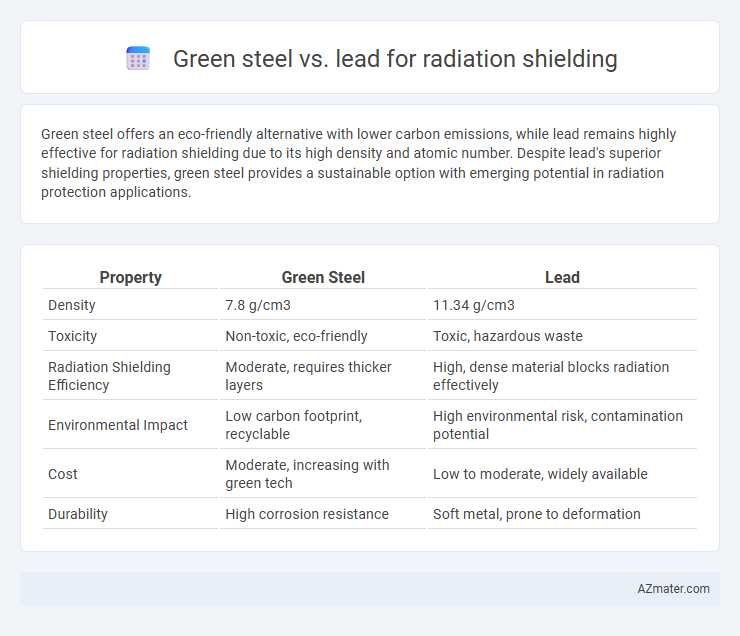Green steel offers an eco-friendly alternative with lower carbon emissions, while lead remains highly effective for radiation shielding due to its high density and atomic number. Despite lead's superior shielding properties, green steel provides a sustainable option with emerging potential in radiation protection applications.
Table of Comparison
| Property | Green Steel | Lead |
|---|---|---|
| Density | 7.8 g/cm3 | 11.34 g/cm3 |
| Toxicity | Non-toxic, eco-friendly | Toxic, hazardous waste |
| Radiation Shielding Efficiency | Moderate, requires thicker layers | High, dense material blocks radiation effectively |
| Environmental Impact | Low carbon footprint, recyclable | High environmental risk, contamination potential |
| Cost | Moderate, increasing with green tech | Low to moderate, widely available |
| Durability | High corrosion resistance | Soft metal, prone to deformation |
Introduction to Radiation Shielding Materials
Radiation shielding materials are essential for protecting human health and sensitive equipment from harmful ionizing radiation in medical, industrial, and nuclear applications. Green steel, an eco-friendly alternative made using low-carbon processes, offers strong density and durability comparable to traditional materials while reducing environmental impact. Lead remains a standard shielding material due to its high atomic number and exceptional radiation attenuation properties, but concerns over its toxicity drive the search for safer, sustainable substitutes like green steel.
Overview of Green Steel: Composition and Benefits
Green steel, primarily composed of recycled scrap and low-carbon iron alloys, incorporates sustainable production methods that significantly reduce greenhouse gas emissions compared to traditional steel manufacturing. Its high density and structural strength provide effective radiation shielding by attenuating gamma rays and other ionizing radiation, making it a viable eco-friendly alternative to lead. Benefits of green steel include recyclability, lower environmental impact, and comparable or enhanced durability, positioning it as a promising material in medical, nuclear, and industrial radiation protection applications.
Lead in Radiation Shielding: Traditional Uses and Drawbacks
Lead has been the conventional material for radiation shielding due to its high density and atomic number, effectively absorbing gamma rays and X-rays in medical, industrial, and nuclear applications. Despite its effectiveness, lead poses significant health and environmental risks, including toxicity, bioaccumulation, and challenges in disposal and recycling. The growing emphasis on sustainable materials is driving research into alternatives, yet lead remains prevalent because of its cost-effectiveness and proven shielding performance.
Environmental Impact: Green Steel vs Lead
Green steel, produced using renewable energy and hydrogen-based reduction methods, drastically reduces carbon emissions compared to traditional lead mining and smelting practices. Lead extraction and processing generate significant environmental pollution, including soil and water contamination with hazardous heavy metals, whereas green steel offers a more sustainable alternative with lower ecological footprints. The lifecycle of green steel supports circular economy principles, minimizing toxic waste and promoting recyclability, making it environmentally preferable for radiation shielding applications.
Mechanical and Structural Properties Comparison
Green steel exhibits superior mechanical strength and structural integrity compared to lead, making it more suitable for load-bearing radiation shielding applications. Its higher tensile strength and hardness provide enhanced durability under stress, while lead's softness and high density primarily offer better gamma radiation attenuation but lack mechanical robustness. Consequently, green steel enables more reliable long-term structural stability in shielding constructions without compromising protective performance.
Radiation Attenuation Efficiency: Green Steel vs Lead
Green steel offers a promising alternative to lead for radiation shielding due to its comparable radiation attenuation efficiency combined with lower environmental impact. While lead has traditionally been preferred for its high density and effective gamma radiation blocking capabilities, green steel achieves similar attenuation performance through alloying and structural advancements that enhance neutron and gamma absorption. Innovations in green steel composites result in materials that not only reduce radiation exposure effectively but also mitigate toxicity and disposal issues associated with lead.
Health and Safety Considerations
Green steel, composed primarily of recycled and low-carbon materials, offers robust radiation shielding properties while significantly reducing environmental toxins compared to traditional lead barriers. Lead, although highly effective in blocking radiation due to its high density, poses serious health risks including lead poisoning and long-term environmental contamination during manufacturing and disposal. Prioritizing green steel enhances workplace safety by minimizing hazardous exposure, ensuring sustainable radiation protection solutions in medical and industrial settings.
Cost Analysis and Economic Viability
Green steel offers a cost-efficient alternative to lead for radiation shielding by combining lower production emissions with competitive material costs, reducing long-term expenses in environmentally conscious projects. Although lead has traditionally been favored for its high density and shielding effectiveness, its toxicity and disposal costs increase overall economic burdens. Lifecycle cost analysis reveals green steel's potential for improved economic viability, especially when factoring in regulatory compliance and sustainability incentives.
Future Prospects and Innovations in Radiation Shielding
Green steel, produced with reduced carbon emissions, offers promising future prospects in radiation shielding due to its sustainable manufacturing and potential for alloy customization that enhances radiation attenuation. Innovations in lead alternatives emphasize eco-friendly, lightweight composites embedded with nanomaterials to improve gamma and X-ray shielding efficiency while overcoming lead's toxicity and disposal challenges. Advanced research focuses on integrating green steel with these novel materials to create hybrid shields that optimize durability, environmental impact, and protection in medical and nuclear applications.
Conclusion: Choosing the Optimal Material for Radiation Protection
Green steel offers a sustainable and effective alternative to traditional lead for radiation shielding, combining high density with lower environmental impact and recyclability. Lead remains a highly efficient material due to its superior atomic number and ability to attenuate a wide range of radiation types, making it ideal for applications requiring maximum protection. The optimal choice depends on balancing environmental considerations, radiation protection efficiency, weight constraints, and cost factors specific to the intended application.

Infographic: Green steel vs Lead for Radiation shielding
 azmater.com
azmater.com